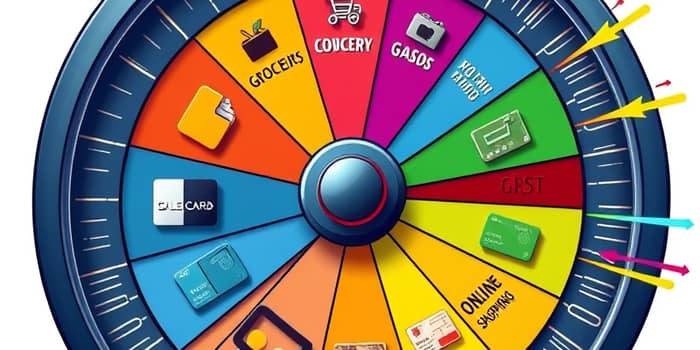
Your money can work harder for you—not just in savings or investments, but through every purchase you make. By understanding how rotating category credit cards operate, you can unlock 5% cash back per quarter and transform everyday spending into tangible rewards. This approach demands a little planning but delivers a substantial boost to your earnings over time. In the following sections, we will break down the essentials, walk you through practical examples, and reveal strategies for genuine reward maximization.
Whether you’re a seasoned cardholder or new to rewards programs, this article will equip you with the knowledge to decide if rotating category cards belong in your wallet. We will explore functionality, popular options, earning potentials, and best practices for upkeep and activation. By the end, you will have a clear roadmap to optimize your cash back journey and feel confident turning quarterly categories into long-term value.
Rotating category credit cards typically offer elevated cash back—most commonly 5%—on specific spending categories that change quarterly. These categories might include grocery stores, gas stations, restaurants, or major retailers such as Amazon.com, Target, and Walmart. The issuer defines these bonus categories in advance, giving you a roadmap for where and when to concentrate your purchases.
Each quarter usually requires you to activate the category rewards through the issuer’s website or mobile app. Once activated, eligible purchases within the specified group earn the higher rate. After you meet the quarterly spending cap, any additional purchases revert to the card’s standard cash back rate, often 1%.
The rotating category structure is straightforward but demands attention. Every three months, a new set of bonus categories goes into effect. Cardholders log in to their account, click an enrollment or activation button, and confirm their participation for the upcoming quarter.
Once activated, you must track your spending relative to the cap. At 5% back on up to $1,500 each quarter, you can earn a maximum of $75 per quarter ($300 annually). Beyond that cap, the card usually reverts to a 1% cash back rate for all additional purchases until the next quarter commences.
Different issuers may have slightly varying activation deadlines and posting times. Some cards require activation by the 10th day of the new quarter, while others allow activation throughout the quarter but only apply the bonus prospectively. Always check the fine print to ensure your purchases are correctly categorized and posted within the qualifying window—mistakes here can mean forfeited rewards.
For example, if groceries become a bonus category on April 1, and you activate on April 15, purchases made between those dates may not earn 5% back. Likewise, if your issuer posts transactions several days after purchase, aim to make larger purchases earlier in the quarter to ensure full bonus credit.
Several issuers compete in this space, each bringing slightly different value propositions:
When choosing between issuers, consider not just the bonus rate but also the ease of activation and the clarity of communications. Some cards send quarterly email reminders or push notifications, while others may require you to proactively check the website. The speed at which bonus categories are updated and reflected in your online portal can vary, affecting your ability to track qualified spending in real time.
Maximizing your return means strategically aligning your spending with the bonus categories. If you spend the full $1,500 cap each quarter in 5% categories, your total bonus cash back equals $300 annually. Pair this with the base rewards on non-bonus spending, and your overall yield can exceed many flat-rate cards.
Consider this example: in Q1, groceries and gas stations earn 5%. If you spend $1,400 on groceries and $600 on gas, $1,500 earns 5% ($75) and $500 earns 1% ($5), for a total of $80 that quarter. Multiply that pattern, and you see why discipline and tracking are so valuable.
Pairing rotating category cards with a high flat-rate cash back card can cover spending beyond the cap, ensuring every dollar earns at least 1.5%–2% back. This combination strategy amplifies your overall yield and minimizes unproductive purchases. Monitoring both cards month to month can boost your compounded savings considerably, turning routine expenses into a reliable source of returns.
Strategic planning and a little organization turn these cards into powerhouse earners. Follow these key tactics:
Additionally, time large or discretionary purchases—like home improvement projects or holiday shopping—to coincide with the most relevant bonus quarter. This timing can yield up to $75 per quarter in maximum returns on planned expenses.
Beyond timing, consider grouping household expenses. For instance, buy gift cards at grocery stores during a quarter when groceries qualify, then use them later for holiday shopping. This tactic effectively extends your bonus rate to seasonal purchases that may not otherwise align with the bonus category. Always track the gift card balance and expiration policies to avoid inadvertent loss.
Rotating category cards shine when managed properly. These cards can deliver high bonus rates without fees multiple times per year, allowing you to focus purchases where they earn the most. On the flip side, the need to track categories, remember activation windows, and stay within quarterly caps adds complexity. Exclusions or varying category definitions among issuers may also cause confusion, and for very high spenders the capped bonus limit can be a constraint.
These rotating category offerings suit consumers who enjoy monitoring rewards and categories and can match their spending habits to quarterly themes. If you have regular expenses that fit common categories—like groceries, gas, streaming, or home goods—you will benefit most. Pairing rotating cards with flat-rate companions ensures you never leave extra rewards on the table.
Credit score requirements for premium rotating category cards tend to be in the good to excellent range, typically 700 or above. If you are building or repairing credit, start with simpler flat-rate cards to establish history, then graduate to rotating offers once you qualify. Also, if you travel frequently, consider how foreign transaction fees and network acceptance will impact your ability to use these cards abroad.
Rotating category credit cards are not a one-size-fits-all solution, but for the organized and motivated cardholder, they deliver some of the highest cash back opportunities available. By understanding the structure, activating timely, and aligning your spending, you can convert everyday purchases into meaningful returns. Remember to set reminders, track caps, and coordinate with complementary reward programs to build a comprehensive, strategically powerful rewards system.
Embark on this rewards journey by reviewing your past year’s spending trends. Identify the primary categories where you incur regular expenses and compare them with upcoming bonus offerings. With focused planning and simple reminders, you will steadily elevate your cashback totals—making every purchase count toward valuable rewards.
References













